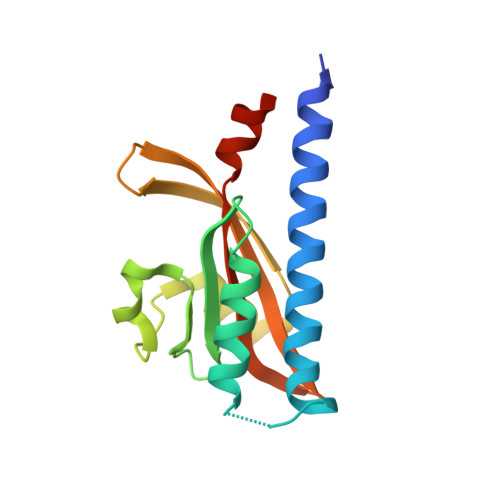Structural Studies on the Extracellular Domain of Sensor Histidine Kinase YycG from Staphylococcus aureus and Its Functional Implications
Kim, T., Choi, J., Lee, S., Yeo, K.J., Cheong, H.K., Kim, K.K.(2016) J Mol Biology 428: 3074-3089
- PubMed: 27389096
- DOI: https://doi.org/10.1016/j.jmb.2016.06.019
- Primary Citation of Related Structures:
5IS1 - PubMed Abstract:
Bacterial two-component signal transduction systems are used to adapt to fluctuations in the environment. YycG, a key two-component histidine kinase in Staphylococcus aureus, plays an essential role in cell viability and regulates cell wall metabolism, biofilm formation, virulence, and antibiotic resistance. For these reasons, YycG is considered a compelling target for the development of novel antibiotics. However, to date, the signaling mechanism of YycG and its stimulus are poorly understood mainly because of a lack of structural information on YycG. To address this deficiency, we determined the crystal structure of the extracellular domain of S. aureus YycG (YycGex) at 2.0-Å resolution. The crystal structure indicated two subunits with an extracellular Per-Arnt-Sim (PAS) topology packed into a dimer with interloop interactions. Disulfide scanning using cysteine-substituted mutants revealed that YycGex possessed dimeric interfaces not only in the loop but also in the helix α1. Cross-linking studies using intact YycG demonstrated that it was capable of forming high molecular weight oligomers on the cell membrane. Furthermore, we also observed that two auxiliary proteins of YycG, YycH and YycI, cooperatively interfered with the multimerization of YycG. From these results, we propose that signaling through YycG is regulated by multimerization and binding of YycH and YycI. These structural studies, combined with biochemical analyses, provide a better understanding of the signaling mechanism of YycG, which is necessary for developing novel antibacterial drugs targeting S. aureus.
- Department of Molecular Cell Biology, Samsung Biomedical Research Institute, Sungkyunkwan University School of Medicine, Suwon 440-746, Republic of Korea.
Organizational Affiliation:
















